H.H.Stern 语言教学的基本概念总结资料
- 格式:doc
- 大小:143.50 KB
- 文档页数:17
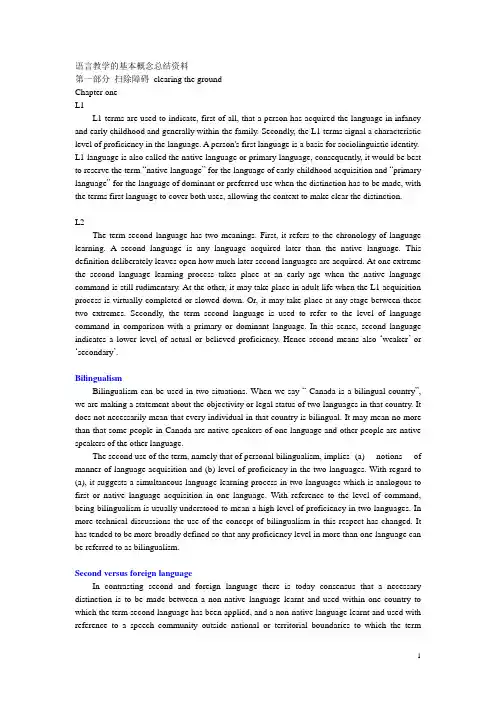
语言教学的基本概念总结资料第一部分扫除障碍clearing the groundChapter oneL1L1 terms are used to indicate, first of all, that a person has acquired the language in infancy and early childhood and generally within the family. Secondly, the L1 terms signal a characteristic level of proficiency in the language. A person's first language is a basis for sociolinguistic identity. L1 language is also called the native language or primary language, consequently, it would be best to reserve the term “native language” for the language of early-childhood acquisition and “primary language” for the language of dominant or preferred use when the distinction has to be made, with the terms first language to cover both uses, allowing the context to make clear the distinction.L2The term second language has two meanings. First, it refers to the chronology of language learning. A second language is any language acquired later than the native language. This definition deliberately leaves open how much later second languages are acquired. At one extreme the second language learning process takes place at an early age when the native language command is still rudimentary. At the other, it may take place in adult life when the L1 acquisition process is virtually completed or slowed down. Or, it may take place at any stage between these two extremes. Secondly, the term second language is used to refer to the level of language command in comparison with a primary or dominant language. In this sense, second language indicates a lower level of actual or believed proficiency. Hence second means also ‘weaker’or ‘secondary’.BilingualismBilingualism can be used in two situations. When we say “ Canada is a bilingual country”, we are making a statement about the objectivity or legal status of two languages in that country. It does not necessarily mean that every individual in that country is bilingual. It may mean no more than that some people in Canada are native speakers of one language and other people are native speakers of the other language.The second use of the term, namely that of personal bilingualism, implies (a) notions of manner of language acquisition and (b) level of proficiency in the two languages. With regard to (a), it suggests a simultaneous language learning process in two languages which is analogous to first or native language acquisition in one language. With reference to the level of command, being bilingualism is usually understood to mean a high level of proficiency in two languages. In more technical discussions the use of the concept of bilingualism in this respect has changed. It has tended to be more broadly defined so that any proficiency level in more than one language can be referred to as bilingualism.Second versus foreign languageIn contrasting second and foreign language there is today consensus that a necessary distinction is to be made between a non-native language learnt and used within one country to which the term second language has been applied, and a non-native language learnt and used with reference to a speech community outside national or territorial boundaries to which the termforeign language is commonly given. A second language usually has official status or a recognized function within a country which a foreign language has not.The purposes of second language are quite different from foreign language. Second language is needed for the full participation in the political or economical life of the nation since it is the official language or educational language, while the foreign language learners hold a variety of purposes in mind, such as traveling or communicating with native speakers.A second language, because it is used within the country, is learnt with much more environmental support than a foreign language whose speech community may be thousands of miles away. A foreign language usually requires more formal instruction and other measures compensating for the lack of environmental support. By contrast, a second language is often learnt informally because of its widespread use within the environment.International language / intranational languageSecond and foreign language learning both imply a specified speech community or communities as a territorial reference or contact group. International or intranational language lack this characteristic. Thus, English in India which has the status of an official language but has no specified reference group, is learnt as a means of intranational communication. If English is learnt in many countries across the world, this is not only with reference to specified English-speaking territories, but as a means of international communication across national boundaries among speakers of other language. For this role the term international language has been proposed.Language learningThe psychological concept of learning includes not only learning of skills and acquisition of knowledge. It refers also to learning to learn and learning to think. Language learning is also widely concerned, it includes all kinds of language learning.From the perspective of the psychology of learning, learning has been approached in two main ways: (1) through theoretical and experimental studies and (2) through empirical studies in educational settings.With regards to the (1), broadly speaking, two groups can be distinguished. The first, derived from the British associationist school of philosophy, adopts a largely environmentalist view of man. Modern milestone in the development of this position are Watson’s behaviorism, Skinner’s operate conditioning, etc. Theories in this school of thought, so-called S-R theories, are characterized by emphasis on externally observable response to specific stimuli, an empirical and experimental approach, and the avoidance of subjective or mentalist concept. The psychology of learning, according to this viewpoint, therefore, is a study of learning phenomena which disregards the intentions, the thinking, the conscious planning and internal processes of the learner.The other trend of thought on learning is cognitive approaches to learning, of which an early representative was Gestalt psychology. It had laid emphasis on innate organizing principles in human perception, cognition, sensorimotor skills, learning, and even in social conduct. For Gestalt theory, it is impossible to represent human learning without concepts of subjective experience, such as the sudden click of understanding. Gestalt psychology was able to throw light on perceptual and cognitive learning by describing and demonstrating the subjective cognitive experiences of the learner with such concepts as ‘whole and part’, field, structure, andorganization.Without necessarily subscribing to all the concepts of the Gestalt school, some psychologists have developed a cognitive theory of learning. They lay emphasis on meaningful learning, meaning being understood not as a behavioral response, but as a conscious experience which emerges when potentially meaningful signs, symbols or concepts are related to and incorporated within a given individual’s cognitive structure.As far as the empirical studies of learning are concerned, psychology has also investigated learning problems from the applied side in practical learning situations. Critics have deplored the wide gap between the classroom learning theory and the theoretical and laboratory study of learning.Categories of the psychology of learning, commonly applied to formal educational activities, refer to (a) characteristics of the learners and individual differences among learners, (b) different kinds of learning, (c) the learning process and (d) outcomes of learning.(a)Among learner characteristics, factors that are frequently presented in the literature include: (1)the influence of age and maturity on mental development and learning; (2)the influence of heredity and environment on abilities and achievement; (3) specific aptitudes for particular learning tasks, for example, musical aptitude, language learning aptitude, etc. (4) the influence of home and community on motivations and attitudes.(b)What is being learnt has been frequently expressed as three psychological categories. They areconceptual and verbal learning, skill learning and affective and social learning.(c)As for the process of learning, a number of distinctions have been introduced. One is on thetime-scale of learning: early learning in contrast with the later learning; learning processes may further differ in the degree of awareness or volitional control on the part of the learner: the conscious learning and the latent learning,, the distinction introduced by Krashen between language learning and language acquisition refers to this identification. The contrast between mechanical learning and cognitive learning refers to the degree of conceptual understanding of the learning task by learners.(d)Lastly, the needs of assessing the outcome of learning have led to the development of tests ofachievement and proficiency. Techniques of measurement and evaluation, which psychometrics has contributed to educational psychology, have an obvious relevance for the assessment of language learning.Learning and acquisitionThe American applied linguist Krashen uses the term “acquisition’to describe second language learning which is analogous to the way in which a child acquires his first language, that is naturally, without focus on linguistic form, and learning as conscious language development particularly in formal school-like settings.A disadvantage of Krashen’s terminology is that it runs counter to the terms used in psychology which, as we have noted, comprise Krashen’s acquisition and learning as different ways of learning.Language teachingIt can be defined as the activities which are intended to bring about language learning. All that need to be pointed out is that language teaching is more widely interpreted than instructing alanguage class. Formal instruction or methods of training are included, but so is individualized instruction, self-study, computer-assisted instruction, and the use of media, such as radio or television.Chapter two: theory and practiceDefinition of theoryThe word theory is used in three fairly distinct but related senses. When we speak of theory of art, or educational theory, the term theory is used in the first and widest sense (T1). It refers to the systematic study of the thought related to a topic or activity, for example, art, music, or education.Second, under T1, it is possible to subsume different schools of thought or theories (T2), each with their own assumptions, postulates, principles, models and concepts. What we often loosely referred to as language teaching method. Lastly, in the natural and human sciences the concept of theory is employed in a more rigorous third sense(T3) as “ a hypothesis or set of hypotheses that have been verified by observation or experiment’’. The theory of evolution is a case in point.Criteria for a good theoryWe can identify the following criteria as relevant to theory development in language teaching (1) usefulness and applicabilitySince a theory of second language teaching is primarily a theory of practical activities. It should be useful, effective or applicable. It proves its usefulness by making sense of planning, decision making, and practice. It should help decision making both on the broader policy level and at the level of classroom activity. The crucial test of language teaching theory is its effect.InterlanguageAn interlanguage is an emerging linguistic system that has been developed by a learner of a second language (or L2) who has not become fully proficient yet but is only approximating the target language: preserving some features of their first language (or L1) in speaking or writing the target language and creating innovations. An interlanguage is idiosyncratically(特殊物质的, 特殊的, 异质的) based on the learners' experiences with the L2. It can ossify in any of its developmental stages. The learner creates an interlanguage using different learning strategies such as language transfer, overgeneralisation and simplification.Interlanguage is based on the theory that there is a "psychological structure latent in the brain" which is activated when one attempts to learn a second language. Larry Selinker proposed the theory of interlanguage in 1972, noting that in a given situation the utterances produced by the learner are different from those native speakers would produce had they attempted to convey the same meaning. This comparison reveals a separate linguistic system. This system can be observed when studying the utterances of the learners who attempt to produce a target language norm.To study the psychological processes involved one should compare the interlanguage of the learner with two things:Utterances in the native language to convey the same message made by the learnerUtterances in the target language to convey the same message made by the native speaker of that language.Interlanguage yields new linguistic variety. Interlanguage is the basis for diversification of linguistic forms through an outside linguistic influence. Dialects formed by interlanguage are the product of a need to communicate between speakers with varying linguistic ability, and with increased interaction with a more standard dialect, are often marginalized or eliminated in favor of a standard dialect. In this way, interlanguage may be thought of as a temporary tool in language or dialect acquisition.Stephen Krashen & SLAStephen Krashen is professor emeritus at the University of Southern California, and is a linguist, educational researcher, and activist. Krashen has contributed to the fields of second language acquisition (SLA), bilingual education, and reading. He is credited with introducing various influential concepts and terms in the study of second language acquisition, including the distinction between acquisition and learning, the Input Hypothesis, Monitor Theory, the Affective Filter, and the Natural Order Hypothesis.The term "language acquisition" became commonly used after Stephen Krashen contrasted it with formal and non-constructive "learning." However, "second language acquisition" or "SLA" has become established as the preferred term for this academic discipline.Though SLA is often viewed as part of applied linguistics, it is typically concerned with the language system and learning processes themselves, whereas applied linguistics may focus more on the experiences of the learner, particularly in the classroom. Additionally, SLA has mostly examined naturalistic acquisition, where learners acquire a language with little formal training or teaching.The monitor theory 监控理论It was put forward by Krashen in the late 1970s. The theory consists of the following five hypotheses:①The acquisition-learning hypothesis The theory claims that adult learners of a second language have two ways of developing their competence —acquisition and learning. The basic distinction between language acquisition and language learning is whether the learner pays a conscious attention to the rules of the target language. Acquisition refers to the subconscious process in which learners develop their language proficiency. Learning refers to the conscious process in which learners acquire the knowledge of rules of the target language.②The monitor hypothesis Different functions— According to Krashen, acquisition is responsible for the fluency of the utterances produced by speakers while learning is responsible for the accuracy of the speeches or passages. Three conditions — In order to perform this monitor function, language learners have to satisfy at least threeconditions: sufficient time to monitor his production, to have his focus on form, and to have clear knowledge of the rules of the target language.③The natural order hypothesis Same order —The hypothesis claims that foreign language learners acquire the rules of the target language in the same order no matter where, when and how they are learning the language. Speed —In Krashen’s point of view, language teaching cannot change the natural order of language acquisition. It can only facilitate the speed of acquisition.④The input hypothesis Language input and language acquisition—According to Krashen, the only way for people to acquire a language is by understanding messages or receiving comprehensive input. They move from their current level to the next level by understanding input. They move from i, their current level, to i+1, the next level along the natural order, by understanding input containing i+1. That is to say, language is acquired by people’s comprehension of input that is slightly beyond their current level.⑤The affective filter hypothesis Purpose —It attempts to explain the variation in speed of language acquisition among individuals of the same group. The three affective factors which determines the speed of success —motivation, self-confidence, and anxiety. Influence of the three factors —learners with high motivation, self-confidence, and low anxiety will do much better than those that are unmotivated, lacking in self-confidence and concerned too much with failure. That is to say, learners with a low affective filter will get more input than learners with a high affective filter.Error analysisError analysis in SLA was established in the 1960s by Stephen Pit Corder and colleagues (Corder, 1967). Error analysis was an alternative to contrastive analysis, an approach influenced by behaviorism through which applied linguists sought to use the formal distinctions between the learners' first and second languages to predict errors. Error analysis showed that contrastive analysis was unable to predict a great majority of errors, although its more valuable aspects have been incorporated into the study of language transfer. A key finding of error analysis has been that many learner errors are produced by learners making faulty inferences about the rules of the new language.Error analysts distinguish between errors, which are systematic, and mistakes, which are not. They often seek to develop a typology of errors. Error can be classified according to basic type: omissive, additive, substitutive or related to word order. They can be classified by how apparent they are: overt errors such as "I angry" are obvious even out of context, whereas covert errors are evident only in context. Closely related to this is the classification according to domain, the breadth of context which the analyst must examine, and extent, the breadth of the utterance which must be changed in order to fix the error. Errors may also be classified according to the level of language: phonological errors, vocabulary or lexical errors, syntactic errors, and so on. They may be assessed according to the degree to which they interfere with communication: global errors make an utterance difficult to understand, while local errors do not. In the above example, "I angry" would be a local error, since the meaning is apparent.From the beginning, error analysis was beset with methodological problems. In particular, the above typologies are problematic: from linguistic data alone, it is often impossible to reliably determine what kind of error a learner is making. Also, error analysis can deal effectively only with learner production (speaking and writing) and not with learner reception (listening and reading). Furthermore, it cannot account for learner use of communicative strategies such as avoidance, in which learners simply do not use a form with which they are uncomfortable. For these reasons, although error analysis is still used to investigate specific questions in SLA, the quest for an overarching theory of learner errors has largely been abandoned. In the mid-1970s, Corder and others moved on to a more wide-ranging approach to learner language, known as interlanguage.Error analysis is closely related to the study of error treatment in language teaching. Today, the study of errors is particularly relevant for focus on form teaching methodology.Pedagogical grammarPedagogical grammar serves as an intermediary or link between linguistics and pedagogy. Drawing on work in several fields such as linguistics, psychology and second language acquisition theory, pedagogical grammar is of a hybrid nature, which usually denotes grammatical analysis and instruction designed for the needs of second language students. In its expanded view it involves decision making processes on behalf of the teacher which requires careful and time-consuming interdisciplinary work. This process is influenced by the teachers’ cognition, beliefs, assumptions, and attitudes about the teaching of grammar.Noblitt bases his conception of a pedagogical grammar on a fivefold analysis: a pedagogical grammar requires descriptive and contrastive data and concepts, an ordering of the information in terms of skills( listening, speaking, reading, and writing) and in terms of levels of achievement (elementary, intermediate, and advanced), and evaluation procedures, bearing in mind objectives and educational settings for which the pedagogical grammar in intended.What is the relationship between the linguistics and language teaching?The relationship between linguistics and language teaching has moved through different phases. In spite of the early interest in phonetics around the turn of the 20th century, the language teaching remained unaffected until the interwar period. Equally, the linguists ignored the application of linguistics in the pedagogical activities.From about the 1940s to 1960s, there is a confident application of linguistics in the teaching practice. Linguists in the forties in America were fully aware of their role in language teaching. Bloomfield suggested a professional and almost technical approach in teaching the language. The set of the approach was (1) a structural analysis of the language, forming the basis for graded material, (2) presentation of the analysis by a trained linguist, (3) several hours of drill per day with the help of a native speaker and in small classes, and (4) emphasis on speaking as the first objective. The structuralism forms the linguistic basis of the audiolingual method which was prevailing in the 40s and 50s.The new perspective of language offered by transformational generative grammar led to a violent rejection of structuralism and everything it stood for. It shook the foundations of structuralism in linguistics and by implication of audiolingualism in language teaching.Transformational generative grammar recognizes the language as a rule-governed system, therefore, learning a language involves internalizing the rules. Structural linguistics only treats a language as a collection of habits. In language teaching, therefore, it sanctions imitation, memorization, mechanical drills, ect. Chomsky accused the linguists of sharing the myth that linguistic behavior is habitual and that a fixed of stock of patterns ia acquired through practice and used as a basis for analogy. The new version of Chomsky’s theory leads to the disorienting impact of linguistics to language teaching from 1965 to 1970.The sudden ideological changes reopened the entire question of the contribution of linguistics to language teaching. A shift was taken place from applying linguistics directly to treating linguistics as a resource to be drawn on for the benefit of pedagogy with complete independence of mind. The conviction that linguistic studies cannot be applied to language pedagogy without modification led to the formulation of the concept of pedagogical grammar as an intermediary or link between linguistics and pedagogy.Now that we have traced the development of the relations between linguistics and language teaching we will attempt to draw some lessons for the development of our own view of language within a language teaching theory. We will investigate the relationship under the distinction of application and implication and recognize a twofold connection: (1) A language teaching theory incorporates a theory of language, (2) The description of particular language is brought to language teaching.With regard to the theory of language in teaching, a language teaching theory expresses answers to questions about the nature of language. We should identify view of language implicit in language teaching theories from the following 5 aspects:a.analytical and non-analytical approaches to languageA basic question to ask is to what extent the language teaching theory treats the language analytically and therefore adopts a linguistics point of view, or whether it presents the language non-analytically.When we treat language non-analytically, the teaching approaches avoids deliberate study of the language, but the rationale underlying this teaching approach still implies a view of nature of language.As we treat language as an object to be studied, practiced, or manipulated in any way, we must conceptualize it or at least to a certain extent.b. the complexity of languageLinguistic theory has not presented us with a simple and unified picture of language. The second question to ask is : what aspects of language does our language teaching theory include or exclude, and among those that are included, which of these are espically emphasized?We can ask ourselves to what extent the language teaching theory gives priority to phonology, grammar, vocabulary or discourses aspects. Going on from these, we can further ask how it handles these different components of language. Does it deal with them entirely as language forms or structures? Or does it teach them as meanings? And does it place language features into a social context and thus relate the language to the real world?c. the humpty-dumpty effectit is one thing to isolate and analyse different aspects of language, it is quite another to bring the different aspects of the language together. The categories which linguists have devised in order to study an aspect of language more effectively can become troublesome barriers. To overcomethese, linguistics has not only concerned itself with analysis but has also aimed to make a synthesis between the different parts of language. In the same way, the language teacher wishes to teach language as a whole.d. rule versus creativitya language teaching theory, like a linguistic theory, should take into account the regularities( rules, patterns, structures, habits) as well as the possibility of making use of the regularities in varied, novel, and sometimes unique ways as demanded by a given situation.e. a theory of language --- a necessary artifactthe final question to ask is of a more general nature: what are the main characteristics of the view of language in this language teaching theory? Since the language is comprehensive by nature, both the linguistics and teaching should concern the complexity of language and convey it. However, it is impossible to justice to the whole of language, a language teaching theory inevitably demand choices based on an interpretation of language. That is to say, all language teaching theories are artifacts which highlight some aspects of language at the expense of the others.When we come to the description of languages, there is often a discrepancy between descriptive information on a second language and the needs of pedagogy. Therefore an intermediate device, the pedagogical grammar , has been suggested and the following conceptual steps which link theoretical and descriptive linguistics with the development of a language curriculum can be indicated.The descriptive relationship can be divided into six steps. Theoretical linguistics at step I is concerned with the development of general categories and research strategies for studies of particular language. Research at step II can be visualized as detailed studies of linguistic features of particular languages. These studies form the descriptions of given language at step III. The descriptions provide the basis for a pedagogical grammar at step IV. The pedagogical grammar forms the linguistic resource for curriculum development which takes place at step V, with the teaching of language aspect at step VI.Maintaining the dual relationship between linguistics and language teaching is important for language pedagogy, but it is a complex undertaking. The continuing developments in linguistic theory and in language pedagogy as well as the constant changes in the language themselves, demand the permanent study of language and languages and a review of the relations between linguistic theory and language pedagogy.What is communicative competenceCommunicative competence is a linguistic term which refers to a intuitive mastery that the native speaker possesses to use and interpret language appropriately in the process of interaction and in relation to social context.This concept was coined by Hymes in 1972 to constitute a challenge to Chomsky’s linguistic competence which is confined to internalized rules of syntax and abstracts from social rules of language use. Communicative competence no doubt implies linguistic competence but its main focus is the intuitive grasp of social and cultural rules and meanings that are carried by any utterance.The complexity of the entire rule system makes it impossible for anyone except the native。
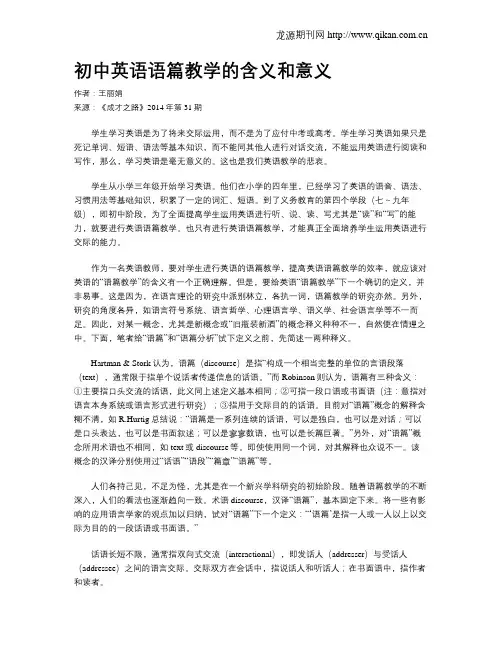
初中英语语篇教学的含义和意义作者:王丽娟来源:《成才之路》2014年第31期学生学习英语是为了将来交际运用,而不是为了应付中考或高考。
学生学习英语如果只是死记单词、短语、语法等基本知识,而不能同其他人进行对话交流,不能运用英语进行阅读和写作,那么,学习英语是毫无意义的。
这也是我们英语教学的悲哀。
学生从小学三年级开始学习英语。
他们在小学的四年里,已经学习了英语的语音、语法、习惯用法等基础知识,积累了一定的词汇、短语。
到了义务教育的第四个学段(七~九年级),即初中阶段,为了全面提高学生运用英语进行听、说、读、写尤其是“读”和“写”的能力,就要进行英语语篇教学。
也只有进行英语语篇教学,才能真正全面培养学生运用英语进行交际的能力。
作为一名英语教师,要对学生进行英语的语篇教学,提高英语语篇教学的效率,就应该对英语的“语篇教学”的含义有一个正确理解。
但是,要给英语“语篇教学”下一个确切的定义,并非易事。
这是因为,在语言理论的研究中派别林立,各执一词,语篇教学的研究亦然。
另外,研究的角度各异,如语言符号系统、语言哲学、心理语言学、语义学、社会语言学等不一而足。
因此,对某一概念,尤其是新概念或“旧瓶装新酒”的概念释义种种不一,自然便在情理之中。
下面,笔者给“语篇”和“语篇分析”试下定义之前,先简述一两种释义。
Hartman & Stork认为,语篇(discourse)是指“构成一个相当完整的单位的言语段落(text),通常限于指单个说话者传递信息的话语。
”而Robinson则认为,语篇有三种含义:①主要指口头交流的话语,此义同上述定义基本相同;②可指一段口语或书面语(注:意指对语言本身系统或语言形式进行研究);③指用于交际目的的话语。
目前对“语篇”概念的解释含糊不清,如R.Hurtig总结说:“语篇是一系列连续的话语,可以是独白,也可以是对话;可以是口头表达,也可以是书面叙述;可以是寥寥数语,也可以是长篇巨著。
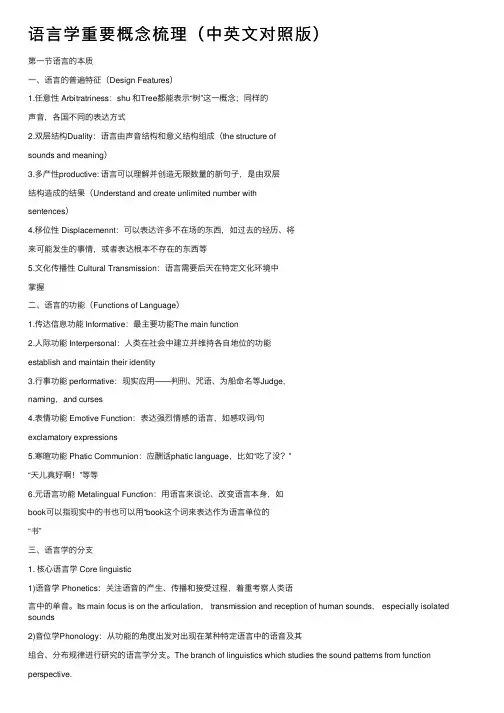
语⾔学重要概念梳理(中英⽂对照版)第⼀节语⾔的本质⼀、语⾔的普遍特征(Design Features)1.任意性 Arbitratriness:shu 和Tree都能表⽰“树”这⼀概念;同样的声⾳,各国不同的表达⽅式2.双层结构Duality:语⾔由声⾳结构和意义结构组成(the structure ofsounds and meaning)3.多产性productive: 语⾔可以理解并创造⽆限数量的新句⼦,是由双层结构造成的结果(Understand and create unlimited number withsentences)4.移位性 Displacemennt:可以表达许多不在场的东西,如过去的经历、将来可能发⽣的事情,或者表达根本不存在的东西等5.⽂化传播性 Cultural Transmission:语⾔需要后天在特定⽂化环境中掌握⼆、语⾔的功能(Functions of Language)1.传达信息功能 Informative:最主要功能The main function2.⼈际功能 Interpersonal:⼈类在社会中建⽴并维持各⾃地位的功能establish and maintain their identity3.⾏事功能 performative:现实应⽤——判刑、咒语、为船命名等Judge,naming,and curses4.表情功能 Emotive Function:表达强烈情感的语⾔,如感叹词/句exclamatory expressions5.寒暄功能 Phatic Communion:应酬话phatic language,⽐如“吃了没?”“天⼉真好啊!”等等6.元语⾔功能 Metalingual Function:⽤语⾔来谈论、改变语⾔本⾝,如book可以指现实中的书也可以⽤“book这个词来表达作为语⾔单位的“书”三、语⾔学的分⽀1. 核⼼语⾔学 Core linguistic1)语⾳学 Phonetics:关注语⾳的产⽣、传播和接受过程,着重考察⼈类语⾔中的单⾳。
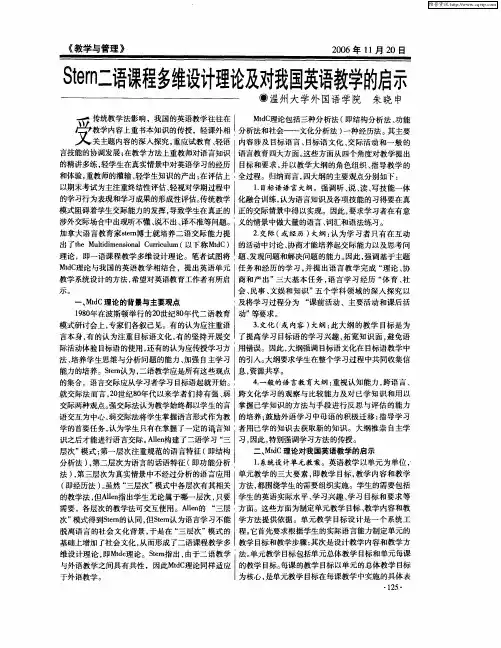
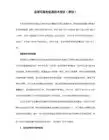
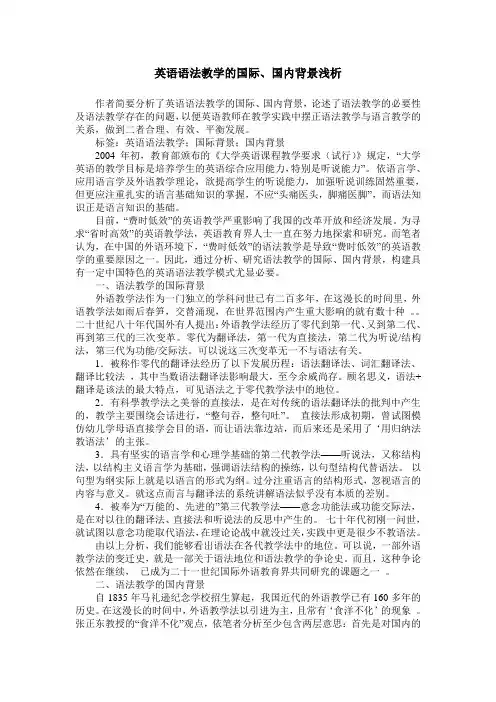
英语语法教学的国际、国内背景浅析作者简要分析了英语语法教学的国际、国内背景,论述了语法教学的必要性及语法教学存在的问题,以便英语教师在教学实践中摆正语法教学与语言教学的关系,做到二者合理、有效、平衡发展。
标签:英语语法教学;国际背景;国内背景2004年初,教育部颁布的《大学英语课程教学要求(试行)》规定,“大学英语的教学目标是培养学生的英语综合应用能力,特别是听说能力”。
依语言学、应用语言学及外语教学理论,欲提高学生的听说能力,加强听说训练固然重要,但更应注重扎实的语言基础知识的掌握,不应“头痛医头,脚痛医脚”,而语法知识正是语言知识的基础。
目前,“费时低效”的英语教学严重影响了我国的改革开放和经济发展。
为寻求“省时高效”的英语教学法,英语教育界人士一直在努力地探索和研究。
而笔者认为,在中国的外语环境下,“费时低效”的语法教学是导致“费时低效”的英语教学的重要原因之一。
因此,通过分析、研究语法教学的国际、国内背景,构建具有一定中国特色的英语语法教学模式尤显必要。
一、语法教学的国际背景外语教学法作为一门独立的学科问世已有二百多年,在这漫长的时间里,外语教学法如雨后春笋,交替涌现,在世界范围内产生重大影响的就有数十种。
二十世纪八十年代国外有人提出:外语教学法经历了零代到第一代、又到第二代、再到第三代的三次变革。
零代为翻译法,第一代为直接法,第二代为听说/结构法,第三代为功能/交际法。
可以说这三次变革无一不与语法有关。
1.被称作零代的翻译法经历了以下发展历程:语法翻译法、词汇翻译法、翻译比较法,其中当数语法翻译法影响最大,至今余威尚存。
顾名思义,语法+翻译是该法的最大特点,可见语法之于零代教学法中的地位。
2.有科學教学法之美誉的直接法,是在对传统的语法翻译法的批判中产生的,教学主要围绕会话进行,“整句吞,整句吐”。
直接法形成初期,曾试图模仿幼儿学母语直接学会目的语,而让语法靠边站,而后来还是采用了‘用归纳法教语法’的主张。
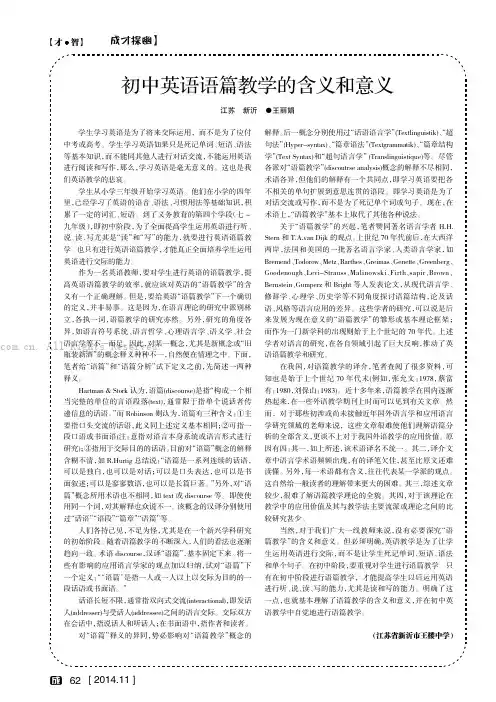
62[2014.11]学生学习英语是为了将来交际运用,而不是为了应付中考或高考。
学生学习英语如果只是死记单词、短语、语法等基本知识,而不能同其他人进行对话交流,不能运用英语进行阅读和写作,那么,学习英语是毫无意义的。
这也是我们英语教学的悲哀。
学生从小学三年级开始学习英语。
他们在小学的四年里,已经学习了英语的语音、语法、习惯用法等基础知识,积累了一定的词汇、短语。
到了义务教育的第四个学段(七~九年级),即初中阶段,为了全面提高学生运用英语进行听、说、读、写尤其是“读”和“写”的能力,就要进行英语语篇教学。
也只有进行英语语篇教学,才能真正全面培养学生运用英语进行交际的能力。
作为一名英语教师,要对学生进行英语的语篇教学,提高英语语篇教学的效率,就应该对英语的“语篇教学”的含义有一个正确理解。
但是,要给英语“语篇教学”下一个确切的定义,并非易事。
这是因为,在语言理论的研究中派别林立,各执一词,语篇教学的研究亦然。
另外,研究的角度各异,如语言符号系统、语言哲学、心理语言学、语义学、社会语言学等不一而足。
因此,对某一概念,尤其是新概念或“旧瓶装新酒”的概念释义种种不一,自然便在情理之中。
下面,笔者给“语篇”和“语篇分析”试下定义之前,先简述一两种释义。
Hartman &Stork 认为,语篇(discourse)是指“构成一个相当完整的单位的言语段落(text),通常限于指单个说话者传递信息的话语。
”而Robinson 则认为,语篇有三种含义:①主要指口头交流的话语,此义同上述定义基本相同;②可指一段口语或书面语(注:意指对语言本身系统或语言形式进行研究);③指用于交际目的的话语。
目前对“语篇”概念的解释含糊不清,如R.Hurtig 总结说:“语篇是一系列连续的话语,可以是独白,也可以是对话;可以是口头表达,也可以是书面叙述;可以是寥寥数语,也可以是长篇巨著。
”另外,对“语篇”概念所用术语也不相同,如text 或discourse 等。
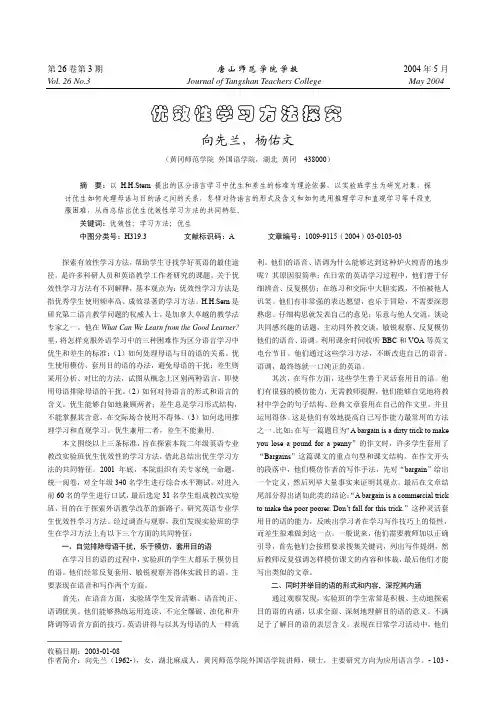
第26卷第3期 唐山师范学院学报 2004年5月 Vol. 26 No.3 Journal of Tangshan Teachers College May 2004────────── 收稿日期:2003-01-08作者简介:向先兰(1962-),女,湖北麻成人,黄冈师范学院外国语学院讲师,硕士,主要研究方向为应用语言学。
- 103 -优效性学习方法探究向先兰,杨佑文(黄冈师范学院 外国语学院,湖北 黄冈 438000)摘 要:以H.H.Stern 提出的区分语言学习中优生和差生的标准为理论依据,以实验班学生为研究对象,探讨优生如何处理母语与目的语之间的关系,怎样对待语言的形式及含义和如何选用推理学习和直观学习等手段克服困难,从而总结出优生优效性学习方法的共同特征。
关键词:优效性;学习方法;优生中图分类号:H319.3 文献标识码:A 文章编号:1009-9115(2004)03-0103-03探索有效性学习方法,帮助学生寻找学好英语的最佳途径,是许多科研人员和英语教学工作者研究的课题。
关于优效性学习方法有不同解释,基本观点为:优效性学习方法是指优秀学生使用频率高、成效显著的学习方法。
H.H.Sern 是研究第二语言教学问题的权威人士,是加拿大卓越的教学法专家之一。
他在What Can We Learn from the Good Learner?里,将怎样克服外语学习中的三种困难作为区分语言学习中优生和差生的标准:(1)如何处理母语与目的语的关系。
优生使用模仿、套用目的语的办法,避免母语的干扰;差生则采用分析、对比的方法,试图从概念上区别两种语言,即使用母语排除母语的干扰。
(2)如何对待语言的形式和语言的含义。
优生能够自如地兼顾两者;差生总是学习形式结构,不能掌握其含意,在交际场合使用不得体。
(3)如何选用推理学习和直观学习。
优生兼用二者,差生不能兼用。
本文围绕以上三条标准,旨在探索本院二年级英语专业教改实验班优生优效性的学习方法,借此总结出优生学习方法的共同特征。
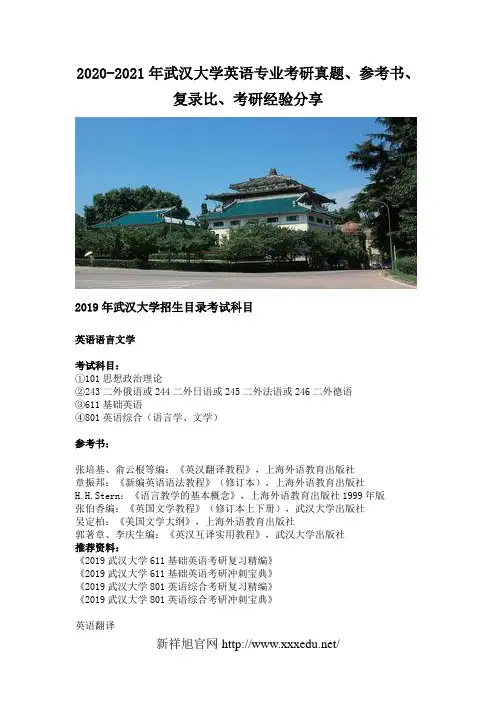
2020-2021年武汉大学英语专业考研真题、参考书、复录比、考研经验分享2019年武汉大学招生目录考试科目英语语言文学考试科目:①101思想政治理论②243二外俄语或244二外日语或245二外法语或246二外德语③611基础英语④801英语综合(语言学、文学)参考书:张培基、俞云根等编:《英汉翻译教程》,上海外语教育出版社章振邦:《新编英语语法教程》(修订本),上海外语教育出版社H.H.Stern:《语言教学的基本概念》,上海外语教育出版社1999年版张伯香编:《英国文学教程》(修订本上下册),武汉大学出版社吴定柏:《美国文学大纲》,上海外语教育出版社郭著章、李庆生编:《英汉互译实用教程》,武汉大学出版社推荐资料:《2019武汉大学611基础英语考研复习精编》《2019武汉大学611基础英语考研冲刺宝典》《2019武汉大学801英语综合考研复习精编》《2019武汉大学801英语综合考研冲刺宝典》英语翻译考试科目:①101思想政治理论②211翻译硕士英语③357英语翻译基础④448汉语写作与百科知识2018年翻译硕士(英语)题型分析(记忆)211翻译硕士英语40道选择题,还好,难度中等,gre词汇还是要背一背改错题有点难,今年阅读比较简单,有一篇是专八练习的原题,讲star alliance 兼并的,作文是human activity makes the world a better place or harms it ?357英语翻译基础词条英汉互译各15个,今年热词考的比较多英译汉:1.Party Constitution;2.CPC national congress;3.oblique translation;4.BRICS;5.European Bank for reconstruction and development;6.polysystem theory,7.taxt exemption;8.text typology,9.property tax;10.craftsman spirit,11.trade and investment liberalization and convenience12.openess and inclusiveness翻译部分考了两篇英译汉是一篇关于语言学的什么二语教学应用学不是很懂汉译英是政府工作报告那种类型的,整整一页,什么提高执政本领啥的448汉语写作与百科知识今年百科其实还算简单,题型没变还是25个选择题,好多都是刘军平那本书上的原题还有1篇应用文,两篇作文应用文是关于申请教育部专项基金的,400字作文一篇是关于就业难问题的还有一篇是命题作文:明者懂得因时而变,知者善于因事而制参考书(初试指定教材):211翻译硕士英语《高级英语》(修订本 1-2册),张汉熙等主编,外语教学与研究出版社(英语专业八级水平)357英语翻译基础《英汉互译实用教程》(修订第三版)郭著章、李庆生,武汉大学出版社;《实用英汉互译技巧》(修订版)汪涛,武汉大学出版社;《西方翻译理论通史》,刘军平,武汉大学出版社;《翻译者手册》,马萧,武汉大学出版社。
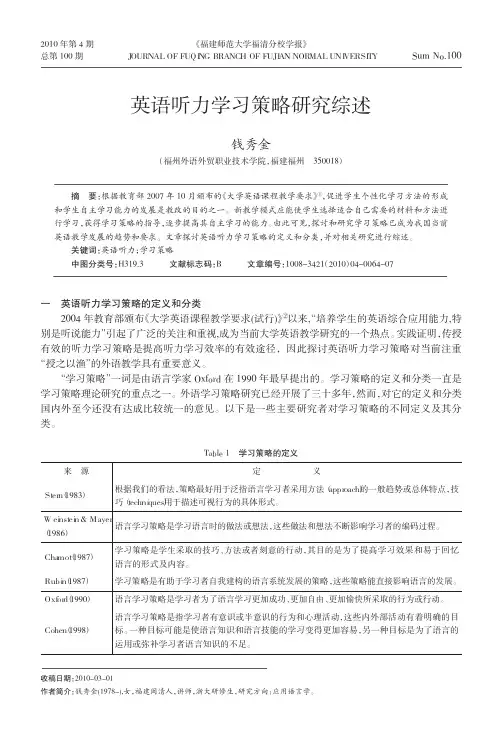
来源定义Stern(1983)根据我们的看法,策略最好用于泛指语言学习者采用方法(approach)的一般趋势或总体特点,技巧(techniques)用于描述可视行为的具体形式。
Weinstein&Mayer(1986)语言学习策略是学习语言时的做法或想法,这些做法和想法不断影响学习者的编码过程。
Chamot(1987)学习策略是学生采取的技巧、方法或者刻意的行动,其目的是为了提高学习效果和易于回忆语言的形式及内容。
Rubin(1987)学习策略是有助于学习者自我建构的语言系统发展的策略,这些策略能直接影响语言的发展。
Oxford(1990)Cohen(1998)语言学习策略是学习者为了语言学习更加成功、更加自由、更加愉快所采取的行为或行动。
语言学习策略是指学习者有意识或半意识的行为和心理活动,这些内外部活动有着明确的目标。
一种目标可能是使语言知识和语言技能的学习变得更加容易,另一种目标是为了语言的运用或弥补学习者语言知识的不足。
收稿日期:2010-03-01作者简介:钱秀金(1978-),女,福建闽清人,讲师,浙大研修生,研究方向:应用语言学。
《福建师范大学福清分校学报》JOURNALOFFUQINGBRANCHOFFUJIANNORMALUNIVERSITY2010年第4期总第100期Sum No.100英语听力学习策略研究综述钱秀金(福州外语外贸职业技术学院,福建福州350018)摘要:根据教育部2007年10月颁布的《大学英语课程教学要求》①,促进学生个性化学习方法的形成和学生自主学习能力的发展是教改的目的之一。
新教学模式应能使学生选择适合自己需要的材料和方法进行学习,获得学习策略的指导,逐步提高其自主学习的能力。
由此可见,探讨和研究学习策略已成为我国当前英语教学发展的趋势和要求。
文章探讨英语听力学习策略的定义和分类,并对相关研究进行综述。
关键词:英语听力;学习策略中图分类号:H319.3文献标志码:B 文章编号:1008-3421(2010)04-0064-07一英语听力学习策略的定义和分类2004年教育部颁布《大学英语课程教学要求(试行)》②以来,“培养学生的英语综合应用能力,特别是听说能力”引起了广泛的关注和重视,成为当前大学英语教学研究的一个热点。
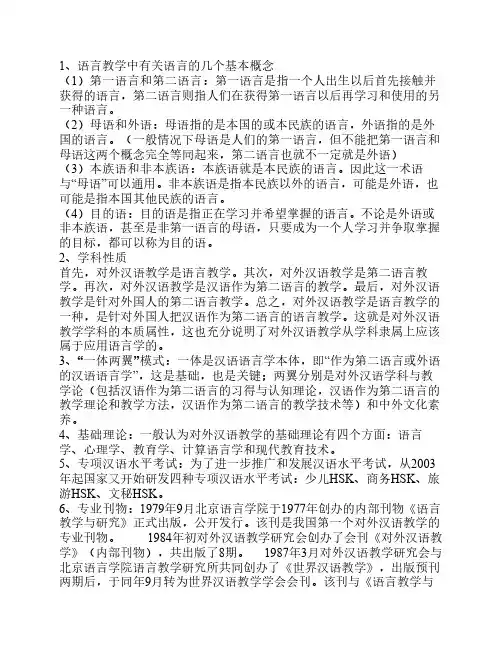
外语教育文选推荐书目一、剑桥书系(外研社)1.情感与语言学习Affect in Language Teaching 协和2.超越专业技术训练Beyond Teaching3.第二语言课堂评估Classroom-based Evaluation in Second Language Education4.交际语言教学论Communicative Language Teaching5.外语与第二语言学习Foreign and Second Language Learning6.语言教师心理学初探Psychology for Language Teaching7.第二语言教师教育Second Language Teacher Education8.语言教师行动研究Action Research for Language Teachers9.交际课堂的任务设计Designing Tasks for the Communicative Classroom10.交互性语言教学Interactive Language Teaching11.第二语言课堂的反思性教学Reflective Teaching in Second Language Classroom12.第二语言课堂的交际浅说Understanding Communication in Second Language二、牛津应用语言学丛书(上海外语教育出版社)1. Howatt, A.P.R A History of English Language Teaching 英语教学史2. Widdowson, H.G. Aspects of Language Teaching 语言教学面面观3. Stern,H. H. Fundamental Concepts of Language Learning 语言教学的基本概念4. Tarone, E.& G. Yule Focus on the Language Learner三、外语教学法丛书(上海外语教育出版社)1. E. Davies & E. Pearse Success in English Teaching 英语教学成功之道协和2. J. Scrivener Learning Teaching: A Guide for English Teachers 学习教学:英语教师指南3. S. Silberstein Techniques and Resources in Teaching Reading 阅读教学的技巧和资源4. M. Lightbown &N. Spada How Languages are learned 语言学习机制四、当代国外语言学与应用语言学文库系列(外研社)1. Harmer, J. How to Teach English 怎样教英语2. Richards,J. et al. Approaches and Methods in Language Teaching 语言教学的流派3. Brow, H.D. Teachings by Principles: An Interactive Approach in Language Pedagogy 根据原理教学:交互式语言教学(这本书比较厚)。
Stern二语课程多维设计理论及对我国英语教学的启示
朱晓申
【期刊名称】《教学与管理(理论版)》
【年(卷),期】2006(000)011
【摘要】受传统教学法影响,我国的英语教学往往在教学内容上重书本知识的传授,轻课外相关主题内容的深入探究,重应试教育、轻语言技能的协调发展;在教学方法上重教师对语言知识的精讲多练,轻学生在真实情景中对英语学习的经历和体验,重教师的灌输、轻学生知识的产出;在评估上以期末考试为主注重终结性评估、轻视对学期过程中的学习行为表现和学习成果的形成性评估.传统教学模式阻碍着学生交际能力的发挥,导致学生在真正的涉外交际场合中出现听不懂、说不出、译不准等问题.
【总页数】2页(P125-126)
【作者】朱晓申
【作者单位】温州大学外国语学院
【正文语种】中文
【中图分类】G63
【相关文献】
1.我国基础教育英语课程发展回眸及启示——基于Stern课程理论
2.初探二语习得理论对我国外教英语教学的启示
3.我国基础教育英语课程发展回眸及启示——
基于Stern课程理论4.初探二语习得理论对我国外教英语教学的启示5.克拉申二语习得理论对我国英语教学的启示
因版权原因,仅展示原文概要,查看原文内容请购买。
英语课程中的语言学基础知识在英语学习过程中,了解语言学的基础知识是非常重要的。
本文将介绍一些英语课程中的语言学基础知识,帮助读者更好地理解和学习英语。
一、语言的定义和特征语言是人类最基本的交流工具,它具有以下几个特征:1. 可以传递信息:语言通过语音、文字等形式传递信息,使人们能够相互理解和沟通。
2. 组成规则性:语言具有一定的语法规则,包括词汇、句子结构等,通过这些规则组织语言的表达。
3. 具有音、义两个层面:语言既有音的层面,即语音学,也有词汇、句法等层面,即语义学。
4. 社会性:语言是社会群体的共同表征,不同社群有不同的语言系统。
二、语音学基础知识语音学研究的是语言的声音部分,包括音素、音节、音变等。
在英语学习中,掌握语音学的基础知识有助于正确发音和理解他人的语音信息。
1. 音素:音素是语言中的最小语音单位,可以区分词义。
英语中有约40个音素,包括元音和辅音。
2. 音节:音节是组成词的基本单位,它包括一个或多个音素。
英语中,音节由元音或元音组合的辅音开头,辅音结尾的形式组成。
3. 重音:重音在英语中具有很重要的作用,它通常落在词的某个音节上,加强了该音节的语音强度和音高。
三、语法学基础知识语法学是语言学中的重要分支,研究的是词汇、句法等语言结构的规则和规律。
掌握基本的语法知识对于理解和使用英语语法非常有帮助。
1. 词汇:词汇是语言中的基本单位,通过词汇可以组成不同的句子和表达。
英语中的词汇分为名词、动词、形容词等不同类别,并具有单复数、时态、语态等语法特征。
2. 句法:句法研究语言中句子的结构和成分之间的关系。
了解句法规则可以帮助我们正确组织句子和理解句子的意义。
3. 语法关系:在句子中,词语之间有很多不同的关系,比如主谓关系、动宾关系、定语从句等,了解这些语法关系对于正确理解句子结构和意义非常重要。
四、语义学基础知识语义学研究语言的意义和词语之间的关系。
在英语学习中,了解语义学基础知识可以帮助学习者更准确地理解和使用英语词汇。
校园英语 / 语言文化研究中国学生对西方文化的态度兰州交通大学/李昕【摘要】语言文化是不可分割的。
学习外语也是学习文化的过程。
在本文中,主要研究关于英美文化。
通过使用问卷调查的方法,研究了兰州交通大学30名在校一年级研究生对西方文化的态度。
结果表明:从认知,情感和行为的角度来看,受试者对西方文化认同度较高,但是他们绝对不会忽视本国的文化。
英语专业与非英语专业对西方文化的认同感存在差异。
本篇论文主要包括五个部分。
第一部分是阐述了研究背景和研究意义;第二部分部分主要梳理目前国内外的研究情况,找出现有研究的缺陷,为本研究撰写奠定基础; 第三章是通过调查问卷对西方文化态度进行调查的实证研究。
第四章回顾了调查问卷的主要发现。
第五章总结了研究的主要发现,同时也提供了相关的教育启示。
【关键词】西方文化 对比研究 问卷调查第一章 介绍1.西方文化简介。
语言承载着一个民族数千年文化传统和智慧的凝结,是民族精神文化的象征。
在全球化的背景下,外语学习和英美文化的传播是不言而喻的。
英美文化作为“强文化”已成为人们生活的一部分。
随着经济全球化的发展,世界各地不同的文化正在通过先进的信息技术和发达的大众传播加速交流与融合,使我们处于一个复杂的多元文化环境中,本文仅以英美文化为例来研究对目前学生学习、生活、娱乐方面的冲击与影响。
2.研究的意义。
在中国,越来越多的青少年成为英语学习的主要群体。
他们乐于接受新思想,这个时代给了他们不同的人生观和价值观。
另一方面,由于他们思维尚未成熟,缺乏社会经验,面对复杂的文化现象时,就不可避免地对此感到困惑。
所以在多民族和多元文化的社会条件下,随着英语及其文化的不断深入,中国学生对英美文化的态度会如何?学生群体之间是否存在态度上的差异?我们怎样才能区分它们呢?这些思路有助于为我培养我国大学生的民族文化认同感,并且为英语教学提供指导意义。
第二章 文献综述1.文化。
“讲英语的国家继续推动英语在世界上的传播,希望培养更多懂得他们的文化,价值观和生活方式的人”。
母语在第二语言教学中的运用作者:陈绍英张鑫来源:《黑龙江教育学院学报》2014年第10期摘要:在第二语言习得过程中,母语不仅能促进第二语言学习,还会对第二语言学习带来干扰,这种现象就是所谓的语言迁移。
语言迁移是第二语言学习中的核心问题,语言迁移分正迁移(Positive Transfer)和负迁移(Negative Transfer)。
基于此,对母语是否应该运用到第二语言教学中,以及何时恰当使用母语,怎样避开母语在二语教学中的负迁移等问题进行探究,同时得出母语在第二语言教学中的作用及启示。
关键词:母语;第二语言;语言迁移中图分类号:H319文献标志码:A文章编号:1001-7836(2014)10-0162-02随着社会经济文化的发展,第二语言教学已开始在许多国家盛行。
母语与第二语言教学的关系密不可分。
母语被定义为语言学习者的第一语言或者本族语言,在第二语言教学中扮演者重要的角色。
自20世纪六七十代起,研究第二语言教学的权威人士H.H.Stern(加拿大)、Rod Ellis(英国)、Odlin(英国)、Michael Long(美国)等人,对母语和第二语言的关系纷纷做出相应的解释,即语言迁移的问题。
因此,语言迁移成为研究母语与第二语言教学中的重要突破点。
1语言迁移的定义对于语言迁移的定义,不同语言学家的侧重点不同,“语言迁移”是美国语言学家Lado于20世纪50年代最先提出来的。
Lado认为学习者的母语是第二语言习得中的主要障碍,母语和目的语之间的差异与其可能导致的困难之间成正比,即“差异=难度”,差异越大,难度就越大。
H.H.Stern(1985)在其著作《语言教学的问题与可选策略》中指出:“从早已熟知的关于L1的知识出发,从不可避免的迁移和干扰现象出发,把这些迁移和干扰的存在看作是外语学习的一种前提”。
Selinker((Rod, Ellis, 1994)将语言迁移看作是构成中介语的最重要因素,同时他认为错误的产生源于母语的干扰[1]。
对Stern的二语教学理论一般模型的总结在《语言教学的基本概念》中,Stern提出了二语教学理论的一般模型。
本文从其提出的背景、目的、特征、内容四方面对这一模型进行总结。
该模型提出的背景。
上世纪七、八十年代,关于语言学和语言教学相互关系的不同模型被提出来,其中有Campbell的理论和实践关系的模型、Spolsky的教育语言学模型、Ingram 的语言教学实践发展的模型、Mackey的语言学习、教学、政策的互动模型、Strevens的语言学习/语言教学过程的模型等。
这些模型从不同角度考虑了语言教学理论发展过程中各因素间的相互作用,如Mackey和Strevens考虑到了社会政治因素,Campbell和Spolsky强调了教育和主要学科之间的关系。
但没有一个完美的模型把影响语言教学的所有因素及其相互关系都考虑在内。
因此,基于Campbell等人的模型,Stern提出了二语教学理论的一般模型。
该模型被提出的目的。
Stern的模型是建立在Campbell等人的模型基础之上的,因此,其模型被提出的目的也综合了上述模型的目的。
像Strevens和Mackey的模型,该模型力求为所有情境下的语言教学提供全面的、分析性的方法;再如Campbell和Spolsky的模型,该模型致力于为语言教学和理论研究提供概念框架,而理论和实践的关系及基础学科(如语言学、心理学、社会学等)语言教学的关系是这一概念框架的关键部分。
简而言之,该模型的目的有四个:一是为理论发展提供概念框架,二是为现存理论的解释和评价提供范畴和标准,三是为语言规划和实践提供必要的理论指导,四是指导理论研究。
(Stern,1999:45)该模型的特征。
Stern(1999:46-47)指出了该模型的四个特征:全面性、互动原则、多因素视角、多学科方法。
首先,如上文目的中所述,全面性指该模型涵盖所有情境中的二语教学与学习:不仅仅指在各个国家的学校、机构中进行的外语教学,也指在跨国的多语言情境中少数民族语言的二语学习。
语言教学的基本概念总结资料第一部分扫除障碍clearing the groundChapter oneL1L1 terms are used to indicate, first of all, that a person has acquired the language in infancy and early childhood and generally within the family. Secondly, the L1 terms signal a characteristic level of proficiency in the language. A person's first language is a basis for sociolinguistic identity. L1 language is also called the native language or primary language, consequently, it would be best to reserve the term “native language” for the language of early-childhood acquisition and “primary language” for the language of dominant or preferred use when the distinction has to be made, with the terms first language to cover both uses, allowing the context to make clear the distinction.L2The term second language has two meanings. First, it refers to the chronology of language learning. A second language is any language acquired later than the native language. This definition deliberately leaves open how much later second languages are acquired. At one extreme the second language learning process takes place at an early age when the native language command is still rudimentary. At the other, it may take place in adult life when the L1 acquisition process is virtually completed or slowed down. Or, it may take place at any stage between these two extremes. Secondly, the term second language is used to refer to the level of language command in comparison with a primary or dominant language. In this sense, second language indicates a lower level of actual or believed proficiency. Hence second means also ‘weaker’or ‘secondary’.BilingualismBilingualism can be used in two situations. When we say “ Canada is a bilingual country”, we are making a statement about the objectivity or legal status of two languages in that country. It does not necessarily mean that every individual in that country is bilingual. It may mean no more than that some people in Canada are native speakers of one language and other people are native speakers of the other language.The second use of the term, namely that of personal bilingualism, implies (a) notions of manner of language acquisition and (b) level of proficiency in the two languages. With regard to (a), it suggests a simultaneous language learning process in two languages which is analogous to first or native language acquisition in one language. With reference to the level of command, being bilingualism is usually understood to mean a high level of proficiency in two languages. In more technical discussions the use of the concept of bilingualism in this respect has changed. It has tended to be more broadly defined so that any proficiency level in more than one language can be referred to as bilingualism.Second versus foreign languageIn contrasting second and foreign language there is today consensus that a necessary distinction is to be made between a non-native language learnt and used within one country to which the term second language has been applied, and a non-native language learnt and used with reference to a speech community outside national or territorial boundaries to which the termforeign language is commonly given. A second language usually has official status or a recognized function within a country which a foreign language has not.The purposes of second language are quite different from foreign language. Second language is needed for the full participation in the political or economical life of the nation since it is the official language or educational language, while the foreign language learners hold a variety of purposes in mind, such as traveling or communicating with native speakers.A second language, because it is used within the country, is learnt with much more environmental support than a foreign language whose speech community may be thousands of miles away. A foreign language usually requires more formal instruction and other measures compensating for the lack of environmental support. By contrast, a second language is often learnt informally because of its widespread use within the environment.International language / intranational languageSecond and foreign language learning both imply a specified speech community or communities as a territorial reference or contact group. International or intranational language lack this characteristic. Thus, English in India which has the status of an official language but has no specified reference group, is learnt as a means of intranational communication. If English is learnt in many countries across the world, this is not only with reference to specified English-speaking territories, but as a means of international communication across national boundaries among speakers of other language. For this role the term international language has been proposed.Language learningThe psychological concept of learning includes not only learning of skills and acquisition of knowledge. It refers also to learning to learn and learning to think. Language learning is also widely concerned, it includes all kinds of language learning.From the perspective of the psychology of learning, learning has been approached in two main ways: (1) through theoretical and experimental studies and (2) through empirical studies in educational settings.With regards to the (1), broadly speaking, two groups can be distinguished. The first, derived from the British associationist school of philosophy, adopts a largely environmentalist view of man. Modern milestone in the development of this position are Watson’s behaviorism, Skinner’s operate conditioning, etc. Theories in this school of thought, so-called S-R theories, are characterized by emphasis on externally observable response to specific stimuli, an empirical and experimental approach, and the avoidance of subjective or mentalist concept. The psychology of learning, according to this viewpoint, therefore, is a study of learning phenomena which disregards the intentions, the thinking, the conscious planning and internal processes of the learner.The other trend of thought on learning is cognitive approaches to learning, of which an early representative was Gestalt psychology. It had laid emphasis on innate organizing principles in human perception, cognition, sensorimotor skills, learning, and even in social conduct. For Gestalt theory, it is impossible to represent human learning without concepts of subjective experience, such as the sudden click of understanding. Gestalt psychology was able to throw light on perceptual and cognitive learning by describing and demonstrating the subjective cognitive experiences of the learner with such concepts as ‘whole and part’, field, structure, andorganization.Without necessarily subscribing to all the concepts of the Gestalt school, some psychologists have developed a cognitive theory of learning. They lay emphasis on meaningful learning, meaning being understood not as a behavioral response, but as a conscious experience which emerges when potentially meaningful signs, symbols or concepts are related to and incorporated within a given individual’s cognitive structure.As far as the empirical studies of learning are concerned, psychology has also investigated learning problems from the applied side in practical learning situations. Critics have deplored the wide gap between the classroom learning theory and the theoretical and laboratory study of learning.Categories of the psychology of learning, commonly applied to formal educational activities, refer to (a) characteristics of the learners and individual differences among learners, (b) different kinds of learning, (c) the learning process and (d) outcomes of learning.(a)Among learner characteristics, factors that are frequently presented in the literature include: (1)the influence of age and maturity on mental development and learning; (2)the influence of heredity and environment on abilities and achievement; (3) specific aptitudes for particular learning tasks, for example, musical aptitude, language learning aptitude, etc. (4) the influence of home and community on motivations and attitudes.(b)What is being learnt has been frequently expressed as three psychological categories. They areconceptual and verbal learning, skill learning and affective and social learning.(c)As for the process of learning, a number of distinctions have been introduced. One is on thetime-scale of learning: early learning in contrast with the later learning; learning processes may further differ in the degree of awareness or volitional control on the part of the learner: the conscious learning and the latent learning,, the distinction introduced by Krashen between language learning and language acquisition refers to this identification. The contrast between mechanical learning and cognitive learning refers to the degree of conceptual understanding of the learning task by learners.(d)Lastly, the needs of assessing the outcome of learning have led to the development of tests ofachievement and proficiency. Techniques of measurement and evaluation, which psychometrics has contributed to educational psychology, have an obvious relevance for the assessment of language learning.Learning and acquisitionThe American applied linguist Krashen uses the term “acquisition’to describe second language learning which is analogous to the way in which a child acquires his first language, that is naturally, without focus on linguistic form, and learning as conscious language development particularly in formal school-like settings.A disadvantage of Krashen’s terminology is that it runs counter to the terms used in psychology which, as we have noted, comprise Krashen’s acquisition and learning as different ways of learning.Language teachingIt can be defined as the activities which are intended to bring about language learning. All that need to be pointed out is that language teaching is more widely interpreted than instructing alanguage class. Formal instruction or methods of training are included, but so is individualized instruction, self-study, computer-assisted instruction, and the use of media, such as radio or television.Chapter two: theory and practiceDefinition of theoryThe word theory is used in three fairly distinct but related senses. When we speak of theory of art, or educational theory, the term theory is used in the first and widest sense (T1). It refers to the systematic study of the thought related to a topic or activity, for example, art, music, or education.Second, under T1, it is possible to subsume different schools of thought or theories (T2), each with their own assumptions, postulates, principles, models and concepts. What we often loosely referred to as language teaching method. Lastly, in the natural and human sciences the concept of theory is employed in a more rigorous third sense(T3) as “ a hypothesis or set of hypotheses that have been verified by observation or experiment’’. The theory of evolution is a case in point.Criteria for a good theoryWe can identify the following criteria as relevant to theory development in language teaching (1) usefulness and applicabilitySince a theory of second language teaching is primarily a theory of practical activities. It should be useful, effective or applicable. It proves its usefulness by making sense of planning, decision making, and practice. It should help decision making both on the broader policy level and at the level of classroom activity. The crucial test of language teaching theory is its effect.InterlanguageAn interlanguage is an emerging linguistic system that has been developed by a learner of a second language (or L2) who has not become fully proficient yet but is only approximating the target language: preserving some features of their first language (or L1) in speaking or writing the target language and creating innovations. An interlanguage is idiosyncratically(特殊物质的, 特殊的, 异质的) based on the learners' experiences with the L2. It can ossify in any of its developmental stages. The learner creates an interlanguage using different learning strategies such as language transfer, overgeneralisation and simplification.Interlanguage is based on the theory that there is a "psychological structure latent in the brain" which is activated when one attempts to learn a second language. Larry Selinker proposed the theory of interlanguage in 1972, noting that in a given situation the utterances produced by the learner are different from those native speakers would produce had they attempted to convey the same meaning. This comparison reveals a separate linguistic system. This system can be observed when studying the utterances of the learners who attempt to produce a target language norm.To study the psychological processes involved one should compare the interlanguage of the learner with two things:Utterances in the native language to convey the same message made by the learnerUtterances in the target language to convey the same message made by the native speaker of that language.Interlanguage yields new linguistic variety. Interlanguage is the basis for diversification of linguistic forms through an outside linguistic influence. Dialects formed by interlanguage are the product of a need to communicate between speakers with varying linguistic ability, and with increased interaction with a more standard dialect, are often marginalized or eliminated in favor of a standard dialect. In this way, interlanguage may be thought of as a temporary tool in language or dialect acquisition.Stephen Krashen & SLAStephen Krashen is professor emeritus at the University of Southern California, and is a linguist, educational researcher, and activist. Krashen has contributed to the fields of second language acquisition (SLA), bilingual education, and reading. He is credited with introducing various influential concepts and terms in the study of second language acquisition, including the distinction between acquisition and learning, the Input Hypothesis, Monitor Theory, the Affective Filter, and the Natural Order Hypothesis.The term "language acquisition" became commonly used after Stephen Krashen contrasted it with formal and non-constructive "learning." However, "second language acquisition" or "SLA" has become established as the preferred term for this academic discipline.Though SLA is often viewed as part of applied linguistics, it is typically concerned with the language system and learning processes themselves, whereas applied linguistics may focus more on the experiences of the learner, particularly in the classroom. Additionally, SLA has mostly examined naturalistic acquisition, where learners acquire a language with little formal training or teaching.The monitor theory 监控理论It was put forward by Krashen in the late 1970s. The theory consists of the following five hypotheses:①The acquisition-learning hypothesis The theory claims that adult learners of a second language have two ways of developing their competence —acquisition and learning. The basic distinction between language acquisition and language learning is whether the learner pays a conscious attention to the rules of the target language. Acquisition refers to the subconscious process in which learners develop their language proficiency. Learning refers to the conscious process in which learners acquire the knowledge of rules of the target language.②The monitor hypothesis Different functions— According to Krashen, acquisition is responsible for the fluency of the utterances produced by speakers while learning is responsible for the accuracy of the speeches or passages. Three conditions — In order to perform this monitor function, language learners have to satisfy at least threeconditions: sufficient time to monitor his production, to have his focus on form, and to have clear knowledge of the rules of the target language.③The natural order hypothesis Same order —The hypothesis claims that foreign language learners acquire the rules of the target language in the same order no matter where, when and how they are learning the language. Speed —In Krashen’s point of view, language teaching cannot change the natural order of language acquisition. It can only facilitate the speed of acquisition.④The input hypothesis Language input and language acquisition—According to Krashen, the only way for people to acquire a language is by understanding messages or receiving comprehensive input. They move from their current level to the next level by understanding input. They move from i, their current level, to i+1, the next level along the natural order, by understanding input containing i+1. That is to say, language is acquired by people’s comprehension of input that is slightly beyond their current level.⑤The affective filter hypothesis Purpose —It attempts to explain the variation in speed of language acquisition among individuals of the same group. The three affective factors which determines the speed of success —motivation, self-confidence, and anxiety. Influence of the three factors —learners with high motivation, self-confidence, and low anxiety will do much better than those that are unmotivated, lacking in self-confidence and concerned too much with failure. That is to say, learners with a low affective filter will get more input than learners with a high affective filter.Error analysisError analysis in SLA was established in the 1960s by Stephen Pit Corder and colleagues (Corder, 1967). Error analysis was an alternative to contrastive analysis, an approach influenced by behaviorism through which applied linguists sought to use the formal distinctions between the learners' first and second languages to predict errors. Error analysis showed that contrastive analysis was unable to predict a great majority of errors, although its more valuable aspects have been incorporated into the study of language transfer. A key finding of error analysis has been that many learner errors are produced by learners making faulty inferences about the rules of the new language.Error analysts distinguish between errors, which are systematic, and mistakes, which are not. They often seek to develop a typology of errors. Error can be classified according to basic type: omissive, additive, substitutive or related to word order. They can be classified by how apparent they are: overt errors such as "I angry" are obvious even out of context, whereas covert errors are evident only in context. Closely related to this is the classification according to domain, the breadth of context which the analyst must examine, and extent, the breadth of the utterance which must be changed in order to fix the error. Errors may also be classified according to the level of language: phonological errors, vocabulary or lexical errors, syntactic errors, and so on. They may be assessed according to the degree to which they interfere with communication: global errors make an utterance difficult to understand, while local errors do not. In the above example, "I angry" would be a local error, since the meaning is apparent.From the beginning, error analysis was beset with methodological problems. In particular, the above typologies are problematic: from linguistic data alone, it is often impossible to reliably determine what kind of error a learner is making. Also, error analysis can deal effectively only with learner production (speaking and writing) and not with learner reception (listening and reading). Furthermore, it cannot account for learner use of communicative strategies such as avoidance, in which learners simply do not use a form with which they are uncomfortable. For these reasons, although error analysis is still used to investigate specific questions in SLA, the quest for an overarching theory of learner errors has largely been abandoned. In the mid-1970s, Corder and others moved on to a more wide-ranging approach to learner language, known as interlanguage.Error analysis is closely related to the study of error treatment in language teaching. Today, the study of errors is particularly relevant for focus on form teaching methodology.Pedagogical grammarPedagogical grammar serves as an intermediary or link between linguistics and pedagogy. Drawing on work in several fields such as linguistics, psychology and second language acquisition theory, pedagogical grammar is of a hybrid nature, which usually denotes grammatical analysis and instruction designed for the needs of second language students. In its expanded view it involves decision making processes on behalf of the teacher which requires careful and time-consuming interdisciplinary work. This pr ocess is influenced by the teachers’ cognition, beliefs, assumptions, and attitudes about the teaching of grammar.Noblitt bases his conception of a pedagogical grammar on a fivefold analysis: a pedagogical grammar requires descriptive and contrastive data and concepts, an ordering of the information in terms of skills( listening, speaking, reading, and writing) and in terms of levels of achievement (elementary, intermediate, and advanced), and evaluation procedures, bearing in mind objectives and educational settings for which the pedagogical grammar in intended.What is the relationship between the linguistics and language teaching?The relationship between linguistics and language teaching has moved through different phases. In spite of the early interest in phonetics around the turn of the 20th century, the language teaching remained unaffected until the interwar period. Equally, the linguists ignored the application of linguistics in the pedagogical activities.From about the 1940s to 1960s, there is a confident application of linguistics in the teaching practice. Linguists in the forties in America were fully aware of their role in language teaching. Bloomfield suggested a professional and almost technical approach in teaching the language. The set of the approach was (1) a structural analysis of the language, forming the basis for graded material, (2) presentation of the analysis by a trained linguist, (3) several hours of drill per day with the help of a native speaker and in small classes, and (4) emphasis on speaking as the first objective. The structuralism forms the linguistic basis of the audiolingual method which was prevailing in the 40s and 50s.The new perspective of language offered by transformational generative grammar led to a violent rejection of structuralism and everything it stood for. It shook the foundations of structuralism in linguistics and by implication of audiolingualism in language teaching.Transformational generative grammar recognizes the language as a rule-governed system, therefore, learning a language involves internalizing the rules. Structural linguistics only treats a language as a collection of habits. In language teaching, therefore, it sanctions imitation, memorization, mechanical drills, ect. Chomsky accused the linguists of sharing the myth that linguistic behavior is habitual and that a fixed of stock of patterns ia acquired through practice and used as a basis for analogy. The new version of Chomsky’s theory leads to the disorienting impact of linguistics to language teaching from 1965 to 1970.The sudden ideological changes reopened the entire question of the contribution of linguistics to language teaching. A shift was taken place from applying linguistics directly to treating linguistics as a resource to be drawn on for the benefit of pedagogy with complete independence of mind. The conviction that linguistic studies cannot be applied to language pedagogy without modification led to the formulation of the concept of pedagogical grammar as an intermediary or link between linguistics and pedagogy.Now that we have traced the development of the relations between linguistics and language teaching we will attempt to draw some lessons for the development of our own view of language within a language teaching theory. We will investigate the relationship under the distinction of application and implication and recognize a twofold connection: (1) A language teaching theory incorporates a theory of language, (2) The description of particular language is brought to language teaching.With regard to the theory of language in teaching, a language teaching theory expresses answers to questions about the nature of language. We should identify view of language implicit in language teaching theories from the following 5 aspects:a.analytical and non-analytical approaches to languageA basic question to ask is to what extent the language teaching theory treats the language analytically and therefore adopts a linguistics point of view, or whether it presents the language non-analytically.When we treat language non-analytically, the teaching approaches avoids deliberate study of the language, but the rationale underlying this teaching approach still implies a view of nature of language.As we treat language as an object to be studied, practiced, or manipulated in any way, we must conceptualize it or at least to a certain extent.b. the complexity of languageLinguistic theory has not presented us with a simple and unified picture of language. The second question to ask is : what aspects of language does our language teaching theory include or exclude, and among those that are included, which of these are espically emphasized?We can ask ourselves to what extent the language teaching theory gives priority to phonology, grammar, vocabulary or discourses aspects. Going on from these, we can further ask how it handles these different components of language. Does it deal with them entirely as language forms or structures? Or does it teach them as meanings? And does it place language features into a social context and thus relate the language to the real world?c. the humpty-dumpty effectit is one thing to isolate and analyse different aspects of language, it is quite another to bring the different aspects of the language together. The categories which linguists have devised in order to study an aspect of language more effectively can become troublesome barriers. To overcomethese, linguistics has not only concerned itself with analysis but has also aimed to make a synthesis between the different parts of language. In the same way, the language teacher wishes to teach language as a whole.d. rule versus creativitya language teaching theory, like a linguistic theory, should take into account the regularities( rules, patterns, structures, habits) as well as the possibility of making use of the regularities in varied, novel, and sometimes unique ways as demanded by a given situation.e. a theory of language --- a necessary artifactthe final question to ask is of a more general nature: what are the main characteristics of the view of language in this language teaching theory? Since the language is comprehensive by nature, both the linguistics and teaching should concern the complexity of language and convey it. However, it is impossible to justice to the whole of language, a language teaching theory inevitably demand choices based on an interpretation of language. That is to say, all language teaching theories are artifacts which highlight some aspects of language at the expense of the others.When we come to the description of languages, there is often a discrepancy between descriptive information on a second language and the needs of pedagogy. Therefore an intermediate device, the pedagogical grammar , has been suggested and the following conceptual steps which link theoretical and descriptive linguistics with the development of a language curriculum can be indicated.The descriptive relationship can be divided into six steps. Theoretical linguistics at step I is concerned with the development of general categories and research strategies for studies of particular language. Research at step II can be visualized as detailed studies of linguistic features of particular languages. These studies form the descriptions of given language at step III. The descriptions provide the basis for a pedagogical grammar at step IV. The pedagogical grammar forms the linguistic resource for curriculum development which takes place at step V, with the teaching of language aspect at step VI.Maintaining the dual relationship between linguistics and language teaching is important for language pedagogy, but it is a complex undertaking. The continuing developments in linguistic theory and in language pedagogy as well as the constant changes in the language themselves, demand the permanent study of language and languages and a review of the relations between linguistic theory and language pedagogy.What is communicative competenceCommunicative competence is a linguistic term which refers to a intuitive mastery that the native speaker possesses to use and interpret language appropriately in the process of interaction and in relation to social context.This concept was coined by Hymes in 1972 to constitute a challenge to Chomsky’s linguistic competence which is confined to internalized rules of syntax and abstracts from social rules of language use. Communicative competence no doubt implies linguistic competence but its main focus is the intuitive grasp of social and cultural rules and meanings that are carried by any utterance.The complexity of the entire rule system makes it impossible for anyone except the native。